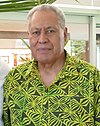Loading AI tools
Head of state of Samoa From Wikipedia, the free encyclopedia
The O le Ao o le Malo (lit. 'chief of the state' in Samoan)[lower-alpha 1] is the ceremonial head of state of Samoa. The position is described in Part III of the 1960 Samoan constitution.[4]
| O le Ao o le Malo of the Independent State of Samoa | |
|---|---|
| O le Ao o le Malo o le Malo Saʻoloto Tutoʻatasi o Sāmoa | |
 | |
 | |
| Style | His Highness |
| Type | Head of state |
| Residence | Vailele[1] |
| Seat | Apia |
| Appointer | Legislative Assembly |
| Term length | Five years, renewable once[2] |
| Constituting instrument | Constitution of Samoa |
| Inaugural holder | |
| Formation | 1 January 1962 |
| Deputy | Members of the Council of Deputies |
| Salary | US$82,000 annually[3] |
| Website | www.samoagovt.ws |
At the time the constitution was adopted, it was anticipated that future heads of state would be chosen from among the four tamaʻāiga paramount chiefs in line with customary protocol. This is not a constitutional requirement, so Samoa can be considered a parliamentary republic rather than a constitutional monarchy. The government Press Secretariat describes the O le Ao o le Malo as a "ceremonial president". The holder is given the formal style of Highness, as are the heads of the four paramount chiefly dynasties. The English title of Head of State (HOS) is also used for the office.[5]
Members of the Council of Deputies act as deputies to the head of state, substituting in the event of a vacancy or when the head of state is unable to fulfil their duties, such as when they are either absent or ill.
The current O le Ao o le Malo is Tuimalealiʻifano Vaʻaletoʻa Sualauvi II, who was elected to a five-year term which started on 21 July 2017. He was re-elected to a second five-year term on 24 August 2022,[6] and renewed his oath of office on 19 October.[7]
The 1960 Samoan constitution stipulated that heads of state were to be elected by the Legislative Assembly for five-year terms. At the same time, it created an exception for the inaugural officeholders, Tupua Tamasese Meaʻole and Malietoa Tanumafili II, named for a lifetime term beginning on Samoa's independence day in 1962.[4][8] They represented, respectively, the paramount lineages of the Tupua Tamasese and Malietoa; both had fiercely competed in a civil war during the late 19th century for control for the four district chieftain titles, known as pāpā.[9]
The two heads of state were jointly known as O Ao o le Malo and individually as O le Ao o le Malo. On the death of one of the joint heads of state, the constitution provided that their surviving counterpart would retain the office alone. The article which constituted their appointment would be sunset once both of their terms were terminated.[4] Meaʻole died in 1963, leaving Tanumafili as sole head of state until his death in 2007, aged 94.[10][11] The first head of state to be elected by the Legislative Assembly was Tui Ātua Tupua Tamasese Efi, who had served two prior terms as Prime Minister and is the elder son of Meaʻole. He was sworn in on 20 June 2007.[12]
The fourth and current head of state, Tuimalealiʻifano Vaʻaletoʻa Sualauvi II, is the great-grandson of Mau movement leader Tuimalealiʻifano Faʻaoloiʻi and nephew of the original member of the Council of Deputies, Tuiaana Tuimalealiʻifano Suatipatipa II. He has held the paramount title of Tuimalealiʻifano since 1977.[13][14]
In 2019, the Samoan government amended the constitution, introducing a two-term limit for the head of state.[2] In November 2021, the government announced that it was considering an amendment to make the office a lifetime appointment. This suggestion was part of a review of the constitution.[15]
The official residence of the head of state was the former home of writer Robert Louis Stevenson, until it was damaged in cyclones in the 1990s; the building subsequently became the Robert Louis Stevenson Museum.[16]
Article 18 of the Samoan constitution sets the qualifications for the position of head of state. They must:
The head of state is elected by the Legislative Assembly for five years and can be re-elected once. The exceptions to this were Tanumafili and Meaʻole, who were exempted from the five-year term laid down by Article 19.[4] A 2019 amendment to the constitution states that the head of state can serve no more than two terms.[2] There was an understanding that the office is to rotate among the four paramount dynasties, of which the most recently elected belongs to the Tuimaleali'ifano lineage.[9]
The termination of a head of state's term can occur in four ways:
The position is that of a ceremonial figurehead, with actual power being held by the Prime Minister, whom the head of state appoints on the recommendation of the Legislative Assembly. While the head of state "does not play an active role in government", they can dissolve the assembly and no act of parliament may become law without their approval – akin to royal assent in monarchies.[17] They may also grant pardons.[18]
To date, there have been four elections for the office of head of state. The first was held on 16 June 2007, in which Tui Ātua Tupua Tamasese Efi was elected unopposed by the 49-member strong parliament. The second was held on 19 July 2012, in which Efi was nominated by Prime Minister Tuila'epa Sa'ilele Malielegaoi and seconded by Palusalue Faʻapo II, the leader of the opposition. The third was held on 30 June 2017, in which Tuimalealiʻifano Vaʻaletoʻa Sualauvi II was elected unopposed.[19] The fourth was held on 23 August 2022, in which Sualauvi II was reelected unopposed.[6]
C Constitutional referendum
D As member of the Council of Deputies
† Died in office
| No. | Portrait | Name
(Birth–Death) |
Elected | Term of office | Political party | Prime minister(s) | ||
|---|---|---|---|---|---|---|---|---|
| Took office | Left office | Time in office | ||||||
| 1 |  |
Tupua Tamasese Meaʻole (1905–1963)[lower-alpha 2] |
1961[C] | 1 January 1962 | 5 April 1963[†] | 1 year, 94 days | Independent | Mulinuʻu II |
| 1 |  |
Malietoa Tanumafili II (1913–2007)[lower-alpha 3] |
1 January 1962 | 11 May 2007[†] | 45 years, 130 days | Independent | Mulinuʻu II Lealofi IV Tupua Kolone Alesana Tuilaʻepa | |
| — |  |
Tui Ātua Tupua Tamasese Efi[D] (born 1938) Acting O le Ao o le Malo |
— | 11 May 2007 | 20 June 2007 | 40 days | Independent | Tuilaʻepa |
| — |  |
Tuimalealiʻifano Vaʻaletoʻa Sualauvi II[D] (born 1947) Acting O le Ao o le Malo |
11 May 2007 | 20 June 2007 | Independent | |||
| 2 |  |
Tui Ātua Tupua Tamasese Efi (born 1938) |
2007 2012 |
20 June 2007 | 21 July 2017 | 10 years, 31 days | Independent | Tuilaʻepa |
| 3 |  |
Tuimalealiʻifano Vaʻaletoʻa Sualauvi II (born 1947) |
2017 2022 |
21 July 2017[20] | Incumbent | 6 years, 20 days | Independent | Tuilaʻepa Mataʻafa |

Seamless Wikipedia browsing. On steroids.
Every time you click a link to Wikipedia, Wiktionary or Wikiquote in your browser's search results, it will show the modern Wikiwand interface.
Wikiwand extension is a five stars, simple, with minimum permission required to keep your browsing private, safe and transparent.